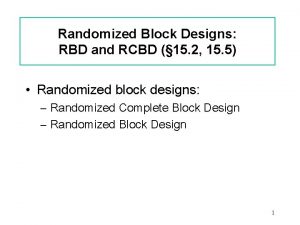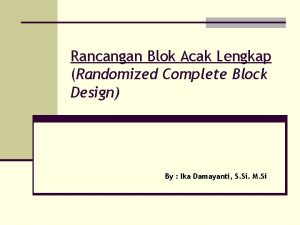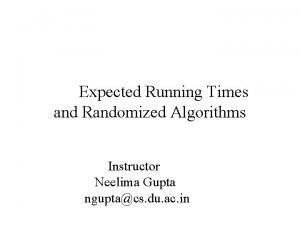Why to Randomize a Randomized Controlled Trial and
























- Slides: 24

Why to Randomize a Randomized Controlled Trial? (and how to do it) John Matthews University of Newcastle upon Tyne

Schema of a simple trial Randomize Rx group 1 Eligible patients Rx group 2

Outline of talk • Many aspects to a trial: this talk focuses on just two • Why you should randomize – benefits of doing so – dangers of failing to do so • How to randomize – often glossed over & unspecified

Why Randomize? • • Compare groups at the end of the trial Difference is because of the Rx For this you need comparable groups Purpose of randomization is to make the treatment groups comparable • Ensures that only difference in groups is due to trial treatments

How does it do it? • Each group is a random sample of eligible patients, so both are representative of that same population • In this sense they are comparable – same proportions of males, stage IV tumours, ambulant cases, elderly patients etc. • Anything which subsequently changes the groups will destroy this balance.

Why Randomize? • Other benefits are – Randomization is largely unpredictable • Why this is a good thing and why it might not obtain will emerge in the talk – Randomization provides a valid basis for statistical inference • This is important but is not addressed at all in this talk

What is wrong with nonrandomized studies? • Two main types of study, those with and those without concurrent control groups

Non-randomized studies II • Without concurrent controls – Uncontrolled • cannot really make much of such studies if there is any variation in outcomes. – Historical controls • type of patient may change, due to eligibility criteria • environment changes, due to trial • data quality often quite different between groups

Non-randomized studies III • Non-randomized concurrent controls – Alternation – Odd/Even hospital no. or date of birth – First letter of surname • Difficult to argue that one group is different from another but allocation is predictable, so bias can arise from selection of patients: see Keirse (1988) – so randomization must be unpredictable

Features of a RCT • Provide reliable evidence of Rx efficacy • Essentially simple • Much attendant methodology – ensure reliability of evidence – give credibility to results • CONSORT statements www. consort-statement. org indicate good practice in trial reporting

How to Randomize • • Toss a coin Essentially the right thing to do Try not to do it in front of the patient More sophisticated implementations possible

Is coin tossing OK? • OK for big trials • For small trials, such ‘simple randomization’ can lead to imbalance in group sizes

Example: trial with 30 patients • If 30 patients are in a trial randomized using coin tossing there is a 14% chance of 15: 15 split • For 16: 14 chance is 27% • ‘Worse’ than 20: 10 is 10% • Why ‘worse’? • Because imbalance leads to loss of power

Alternatives • Could use a restricted randomization scheme – legitimate, intended to protect power – but often not mentioned in trial report: see Altman & Doré, 1990; Schulz et al. , 1994 • Needs to be done properly • Only ensures similar numbers in groups • Combine with stratification to ensure comparability for prognostic factors

Random Permuted Blocks • An allocation sequence is, e. g. , A, B, A, A, B, B, B, A i. e. 6 As, 4 Bs • This sequence built up by using a computer to ‘toss a coin’ • Random Permuted Blocks (RPBs) is an alternative method which ensures imbalance can never be substantial

RPBs II • All sequences of length 4 comprising 2 As and 2 Bs are 1. AABB 2. ABAB 3. ABBA 4. BBAA 5. BABA 6. BAAB • Generate random sequence of numbers 1 to 6, say 6, 5, 2, 6, … and substitute from above to give allocation sequence of BAAB BABA ABAB BAAB

RPBs III • Such sequences cannot be more than two out of balance • Must be in exact balance after 4, 8, 12, etc. patients have been recruited • So RPBs are, to some extent, predictable • To avoid this, vary block length at random: use blocks of length six (3 t) as well as 4 (2 t)

Is it enough to equalise numbers? • No, can still have imbalance in important prognostic factors – E. g. two groups of size 15: one comprises 14 young children and the other comprises 14 adolescents in a trial for diabetes • Stratify recruitment with respect to age – i. e. use separate allocation sequence within each stratum

Stratification • RPBs can be used without stratification • Stratification without using RPB (or an equivalent device) is nonsensical • Separate allocation sequence in each stratum can become cumbersome with many prognostic factors • e. g. ambulant/not, over/under 55, M/F gives 8 allocation sequences

Minimisation • More complicated, in principle • ensures balance on each factor separately, not for all combinations • keeps track of patients already in trial, computes an imbalance score and allocates to minimise this • can include a random element • Less cumbersome, in practice • largely because you need a computer • Good if there are many prognostic factors

How to serve it all up • Methods for delivering randomisation sequences to the clinic are important. • They hold the key to ensuring adequate concealment of the allocation until the patient has been randomized.

Implementation methods • Need to separate the person who generates allocation from those who assess eligibility • Third party schemes • Telephone randomization service • Pharmacy randomization • Web-based service? • Envelopes • Serially numbered, sealed and opaque

Then what? • You will have two groups that are comparable and free from bias • Well, sort of • You have the best start, certainly • Drop-outs, protocol violations etc. disturb the comparability • Might not have been comparable to start with! • Need to allow for baseline imbalance and stratifying variables

Conclusion • Randomization is needed in all clinical trials • As with most aspects of trial design, the details of how you randomize are important • The analysis needs to respect the design (esp. stratification) and make sensible adjustment for baselines • All looking more awkward if there isn’t a statistician involved. • Some details given at www. mas. ncl. ac. uk/~njnsm/talks/titles. htm
 Advantage of randomized controlled trial
Advantage of randomized controlled trial Sean freeder
Sean freeder Cls timer
Cls timer Korunabilirlik hızı
Korunabilirlik hızı Andreas carlsson bye bye bye
Andreas carlsson bye bye bye The first trial of a controlled experiment allows
The first trial of a controlled experiment allows Probabilistic analysis and randomized algorithms
Probabilistic analysis and randomized algorithms Why are controlled experiments sometimes impossible
Why are controlled experiments sometimes impossible Dont ask why why why
Dont ask why why why The mother of la esmeralda
The mother of la esmeralda Randomized polynomial time
Randomized polynomial time Completely randomized design
Completely randomized design Randomized skip list
Randomized skip list R o x o research design
R o x o research design Difference between rcbd and latin square design
Difference between rcbd and latin square design Rcbd
Rcbd Rbd design example
Rbd design example Types of randomized algorithms
Types of randomized algorithms Rcbd adalah
Rcbd adalah Crd design definition
Crd design definition Randomized hill climbing
Randomized hill climbing What is matched pairs design
What is matched pairs design Expected running time of randomized algorithm
Expected running time of randomized algorithm Randomized design
Randomized design Randomized hill climbing
Randomized hill climbing














































